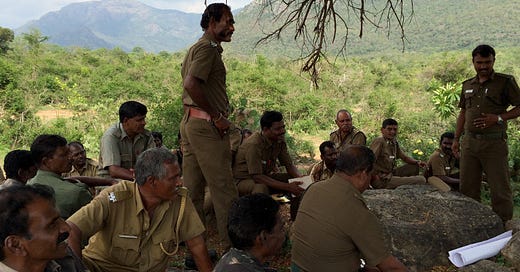Green grabbing: Compensatory afforestation in India
In India, when an area of forest land is cleared, an equivalent area of land has to be afforested. Since 2006, the government has imposed a fee on companies that clear forests for mining, industry, or other projects. The money goes into the Compensatory Afforestation Fund. The Compensation Afforestation Management and Planning Authority (CAMPA) is the organisation responsible for overseeing this afforestation. But the money collected was largely unused.
India’s Compensatory Afforestation Fund Act, passed in 2016, approves the release of the money collected in the Compensatory Afforestation Fund to the forest department to be spent on afforestation projects.
This system of “compensatory afforestation” is described by its proponents as a “win-win”. The environment supposedly wins, because the loss of forest is “compensated”. And business wins because they can clear forest, and hope one day to trade the carbon stored in India’s forests (and plantations) on international carbon markets.
But a three part series of articles by Manasi Karthik and Arpitha Kodiveri provides a detailed critical analysis of “compensatory afforestation”. The series launches their new website POLLNet (The Political Ecology and Law Network).
No consent, no consultation
The rules being drawn up to implement the Compensatory Afforestation Fund Act will weaken the rights of forest dwelling communities recognised under the Forest Rights Act of 2006.
When the Compensatory Afforestation Fund Act was passed, the government promised that forest dwelling communities would be consulted before plantations were established on their lands. “Consulted” is a weakening of the requirement of obtaining consent written into the Forest Rights Act.
Draft rules leaked in 2017 revealed a series of loopholes that would allow forest officials to establish plantations on traditional forests without even consulting local communities.
Redefining “forests”
The Compensatory Afforestation Fund Act makes US$6.2 billion available to what Karthik and Kodiveri describe as “a rapacious post-colonial forest bureaucracy”.
The compensatory afforestation programme regards industrial tree plantations as equivalent to forests. A new definition of forests drafted in 2016, defines forests in terms of tree cover.
But planting trees does not create forests. While forests and plantations both contain trees, they have little else in common. Ricardo Carrere and Larry Lohmann explain in their classic book “Pulping the South”:
A forest is a complex, self-regenerating system, encompassing soil, water, microclimate, energy, and a wide variety of plants and animals in mutual relation. A commercial plantation, on the other hand, is a cultivated area whose species and structure have been simplified dramatically to produce only a few goods, whether lumber, fuel, resin, oil, or fruit.
Or Carbon. Under the UN climate negotiations, forests are now seen as “carbon sinks”. Proponents of compensatory afforestation argue that if a forest is cleared to make way for industrial development, the carbon thus released to the atmosphere can be mitigated by tree planting.
India’s Intended Nationally Determined Contribution states that India’s forest cover has increased, “from 23.4% in 2005 to 24% of the geographical area in 2013”. This has resulted in an increase in the carbon stored in India’s “forests”, “from 6,621.5 million tonnes in 2005 to 6,941 million tonnes in 2013”.
Indian activist Soumitra Ghosh notes that the INDC includes plans for 10 million hectares of new plantations. Ghosh calls India’s climate plans, “the biggest, grandest, greatest carbon offset project ever conceived”.
Green grabbing
The Compensatory Afforestation Fund Act requires that, if forest is cleared, an equal area of non-forest land must be planted with trees. If non-forest land is not available, twice the area of forest land must be planted.
This sets India up for “land acquisition at an unprecedented scale,” Karthik and Kodiveri write. They note that in the eight months up to October 2017, 91,798 hectares of forest land were cleared for 70 different projects. They write that,
The only other instance of a veritable land grab at this scale in India’s history was under the British Empire when colonial rule formally classified forests for the first time and brought them under the control of the Indian Forest Department. Forest tribes across the country were displaced to ensure that a state-run cartel could oil the engines of empire by freely exploiting forests for timber and natural resources. But this enclosure has still not been treated as land acquisition and, till date, the Forest Department remains the largest land-owner in the country.
India’s Ministry of Environment and Forestry has now the Ministry of Environment Forestry and Climate Change. The country has a target of 33% “forest” cover, part of its commitment under the Paris climate agreement.
Forced afforestation
Karthik and Kodiveri write about recent events in Jhadutola village in Jharkhand state in eastern India, to illustrate how compensatory afforestation can be “embroiled in nefarious land dealings that are pushed through by intimidation and harassment”.
In October 2017, villagers in Jhadutola found themselves accused of violating law and order. The villagers said that local police forces had persuaded them to allow “compensatory afforestation” plantations on their land. The villagers wanted to keep farming their land.
No plantations were to be established on land belonging to descendants of a local Zamindar.
There were also rumours that the land to be planted had been bought by an iron ore company with the help of local government officials.
Karthik and Kodiveri write,
It appears that compensatory afforestation in Jhadutola was used to avoid a lengthy and fraught land acquisition process. Companies typically find it difficult to convince multiple stakeholders to voluntarily sell land. So land sales often require someone who can strongarm locals into making the sale.
Compensatory afforestation provides a mechanism for taking villagers’ land and handing it over to the Forest Department. Meanwhile, the destruction of India’s forests for mining, hydropower dams, logging and industrial development continues. All under the cover of addressing climate change.





